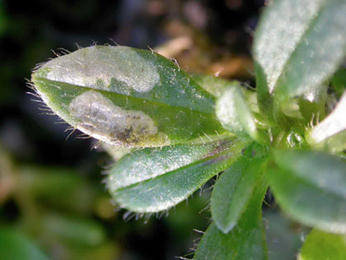|
||||||
|
CUCUBALUS. Berry catchfly. [Caryophyllaceae] |
|
Berry catchfly (C. baccifer) is the only species of Cucubalus recorded in Britain. It is an introduced species. Two British miners are recorded on Cucubalus. A key to the European miners recorded on Silene including Cucubalus is provided in Bladmineerders van Europa. |
Key for the identification of the known mines of British |
1a > Leaf-miner: A white linear-blotch mine, the linear section sometimes not detectable as it becomes enveloped in later blotch (Spencer, 1976: 162-3, figs 296-7). Upper-surface, less often lower-surface, corridor, followed, and often overrun, by a large blotch. Even when the corridor is overun, it usually remains recognisable in the frass pattern. The mine looks whitish in the field. The blotch does not contain much frass, in the form of small black grains, dispersed and stuck to the floor of the mine. Feeding punctures upper-surface (always?). Pupation outside the mine. A common miner, forming a white linear blotch mine (the blotch may obscure the linear portion of the mine) in both native and garden plants.The mine is also illustrated in the Encyclopedia of Life. |
|
Amauromyza flavifrons (Meigen, 1830) [Diptera: Agromyzidae]. |
1b > Leaf-miner: Corridor-blotch mine. The mine starts as a long, narrow, winding corridor running towards the midrib, widening to a blotch. Usually upper-surface, but in small leaves also full-depth parts may occur. The blotch has broad lobes; in their ends most frass is accumulated in the form of green patches or clouds. Sometimes several larvae share mine. Pupation usually in the soil, less often in the leaf (and then generally not in the mine itself but in a small separated mine, that may even be made in the petiole). |
 Mine of Scaptomyza graminum on Cerastium glomeratum Image: © Jean-Yves Baugnée (Bladmineerders van Europa) |
|
Scaptomyza graminum (Fallén, 1823) [Diptera: Drosophilidae]. |
| Last updated 03-Jul-2019 Brian Pitkin | ||
